There is little doubt of the value of social media. You can gain a lot of readers and expand your brand. All of these efforts take a lot of time, so how do you know that what you’re getting back from your efforts is worth your time? What is your return on investment? Does its gain outweigh its cost? How valuable are social media shares?
Measuring ROI with a textbook answer from a traditional business environment doesn’t always work when measuring the effectiveness of a social media campaign. It is difficult to get a precise measurement of everything involved in social media networking. Not everything is measurable, but it is possible to measure specific aspects of your social networking strategies to get your return on investment. You will have to measure and quantify what is tangible. And then, of course, you need to have goals that are tangible.
What Are Your Goals?
The first thing you need to know is what return you want from your investment. You can’t measure your ROI if you don’t have a clear understanding of the return you want. This comes down to your goals. So exactly what are your goals?
- Increased Traffic
- Gain visibility
- Improve reach
- Improve brand awareness
- Support or promote a message
- Gain newsletter signups
- Generate leads
- Increase revenue
- Engage with customers
- Gain marketplace intelligence
- Improve brand loyalty
- Reduce advertising costs by reducing other advertising outlets
The return you want from your investment in social media needs to clearly match your business goals. It comes down to conversion. Does your investment lead to conversion?
Now, which of your goals can be quantified, allowing the goals to be measured?
Tangible vs. Intangible – What Can Be Measured?
Intangible is difficult to measure. It includes:
- Brand awareness
- Connections
- Brand loyalty
Not everything can be quantified because there are often other circumstances involved. You won’t be able to measure every goal.
For example, let’s look at brand loyalty. If you own a used car lot and one of your customers buys a car from someone else, does that mean they were not loyal? There might be circumstances you are not aware of. They might have had to buy a car ASAP and that’s where they happened to be and could not get to your lot. They might have gotten an offer they just could not refuse. They might have wanted a car you didn’t have.
Does it mean they were not loyal because they bought the car of their dreams from someone that gave them too good of a deal to pass up and you don’t sell that brand? Even if they thought of you because of your Twitter campaign, you didn’t have what they needed at that moment in time. That doesn’t mean your campaign was not a success because there was more to the story. How did you even know they bought it in the first place? They might have even told someone else about you, expanding your reach without you knowing it. These are just a few things you might not be able to know, making brand loyalty difficult to measure.
Metrics
The idea is that you would choose metrics that can be measured. If they can be measured they can be quantified. These are tangible. There are several metrics that you can measure. They include:
- Your activity – how much you post, how much time you spend. Cost is more than money, it’s also time. To truly know your investment in time you will need to keep track of it and then assign a dollar amount to that time.
- Traffic – page views, unique visitors, total visitors
- Clicks – the number of clicks that came from social media
- Audience size – the number of subscribers, likes, followers, group members, etc.
- Interaction – likes, retweets, comments, mentions, etc.
- An increase in sales
- Savings in advertising
- Call to action – registrations, sign ups, opt-ins, purchases, etc.
- Newsletter signups
You can place these in a spreadsheet for analysis. Place them in a column for each month. After each month you can show the percentage of change. You can also get a lot of this information from many available online tools. Some are even included within the social media networks themselves.
Analyzing the Results
You can track and analyze your social media effectiveness by using tools. They allow you to track things such as customer engagement through likes, followers, retweets, and fans. The life cycle of a social media campaign is usually short, so you will want to check your analytics often—at least daily.
One effective and fast way to perform your calculations is by using tools such as Hootsuite. Tools that track your analytics usually have ways to save you time. Some of these tools are free. Others come at a premium. Many of them are included with a larger service they provide.
Google Analytics
This is a free tool that tracks website traffic, conversions, downloads, and signups that came from your social media campaigns. You can use a plugin a review your stats directly from your WordPress dashboard, too.
Salesforce
You can add codes to the links you share, and using marketing tools you can track sales leads to specific social media campaigns.
Hootsuite Analytics
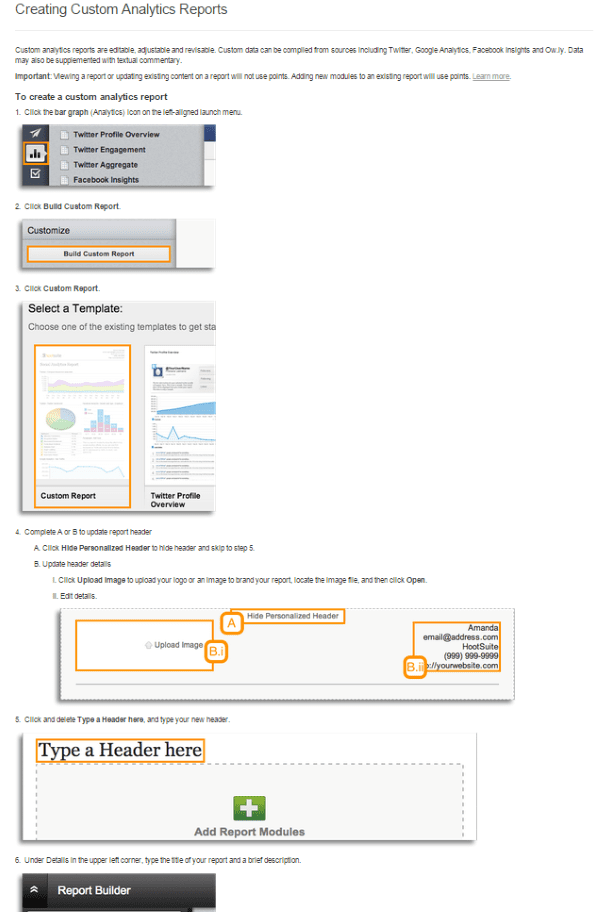
This one provides tools to track reach, conversions, and more. You can create a custom analytics report that will compile information from Twitter, Facebook Insights, Google Analytics, and Ow.ly and get custom graphs and reports.
Buffer for Business
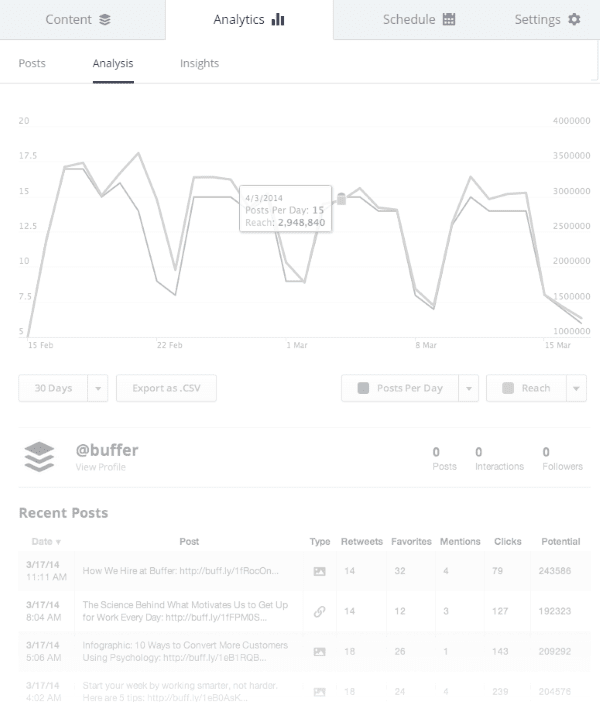
This free tool includes tools to track your social reach. It shows the number of retweets, favorites, mentions, clicks, and potential.
Bitly
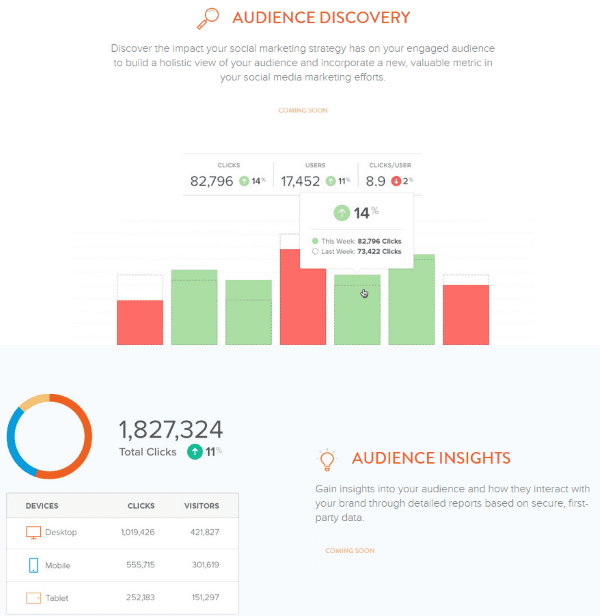
Bitly will track your link clicks so you can know which campaigns and links brought you the most traffic.
Twitter Analytics
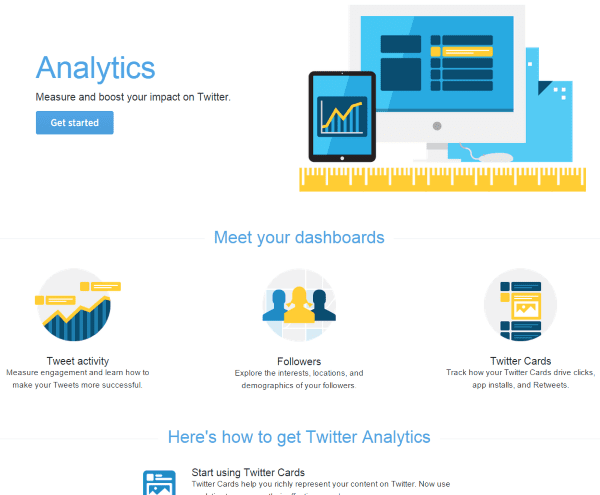
It will measure your engagement, show you the location, interests, and demographics of your followers. Using the Twitter Card system you can know what changes to make to improve your key metrics. You can export analytics from your last 500 posts. Twitter Analytics is built into Twitter and is free to use.
Facebook Insights
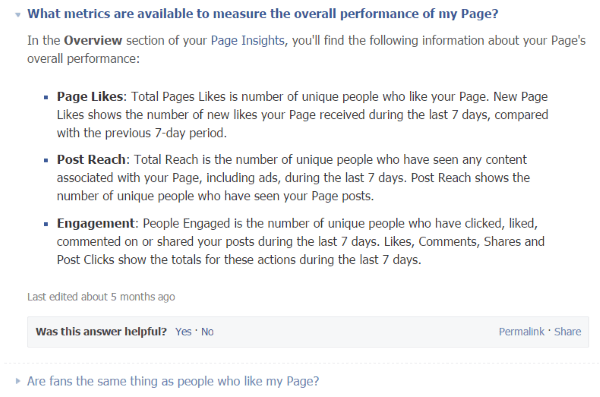
Facebook Insights will give you metrics such as likes, reach, and engagement. It will compare the last 7 days to the previous 7 days. You can use the insights to improve your page. It is built into Facebook and is free to use as well. Plus, you can export 180 days’ worth of data to analyze.
Spreadsheet
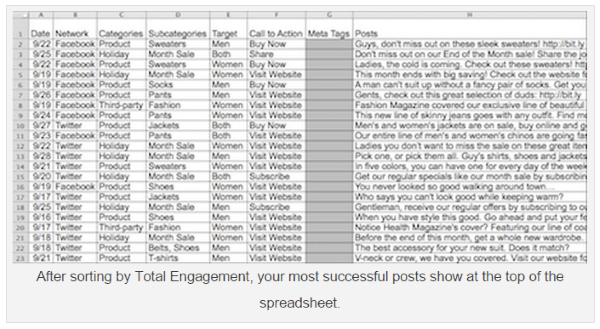
Use a spreadsheet such as Excel to track your data for the long term from multiple sources. You can set it up by the day and get daily, weekly, monthly, and yearly data with ease. There are templates available for virtually any kind of tracking and you can export analytical data into it from many social media tools.
Measuring Your ROI
Once you’ve set your goals and chosen your measuring tools you can now calculate your ROI. Calculating ROI is simply taking the metrics of your results and comparing it to your actual investment. The results should go into a report that can be shared and understood by others. Excel is great for this as you can create charts.
How to Measure Your ROI
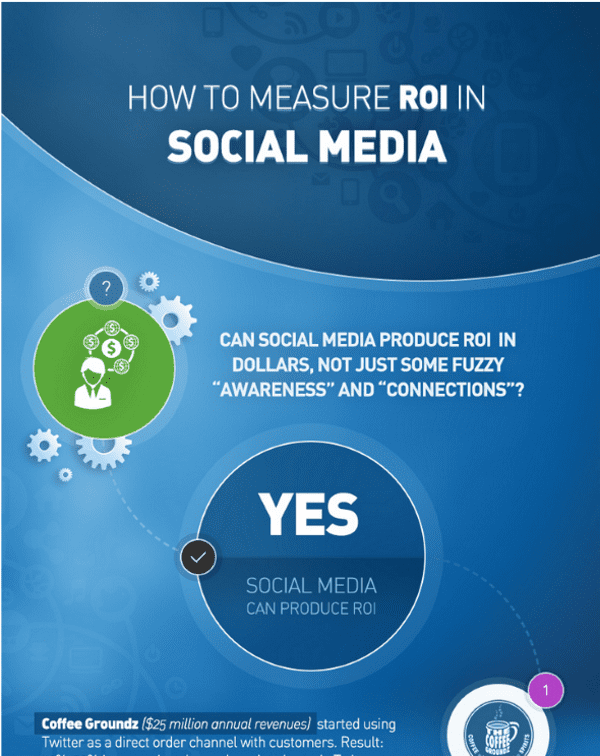
Quicksprout breaks the math down into 6 easy-to-follow steps. Let’s look at each step:
- Measure the increase in revenue
- Track the conversions
- Reach – tracked within the social media platform
- Traffic – the total number of visitors that come to your site
- Leads – the number of leads that come from the social media campaigns
- Customers – the number of leads that become customers
- Conversion rate – the percentage of customers for each social media network
- Assign a monetary value to each conversion
- Historical data – using the lifetime value of each customer, calculate the conversion value
- Guesstimating – using ballpark numbers until you have hard data
- Measure by channel – using your analytical tools
- Determine total costs – includes all fees and labor
- Analyze the results – this will give you the ratio of your cost and gain. You can analyze each social media channel independently so you know which networks and campaigns are working for you.
So, just looking at it monetarily, if after all of your time and energy you found that you spent $1000 on social media efforts and your customers bought $2000 as a result of your social media campaign, your return on investment was $1000.
Improve Your ROI – Reducing the Cost and Improving Your Results
Tracking your results will reveal what works with social media and what does not. You can use this information to know how and where it is best to invest your time in order to get the desired return. This will help you increase the value of your social media campaigns. Social media is not static. You will always need to make adjustments to your strategy in order to meet your goals. You might also need to adjust the type of data you’re tracking.
Reduce the amount of time you spent on social media without reducing the number of posts. When you consider just how many social media networks there are, and if you try to be active on several of them, social media can take a LOT of time. In order to improve your ROI you can reduce the cost by reducing the amount of time it takes to keep active on your networks.
How? Use an app or plugin to handle all of the networks at the same time from a single dashboard. Here are a few to reduce the time you spend on social media and improve your ROI. Many of these tools also provide analytics for easy tracking.
Buffer
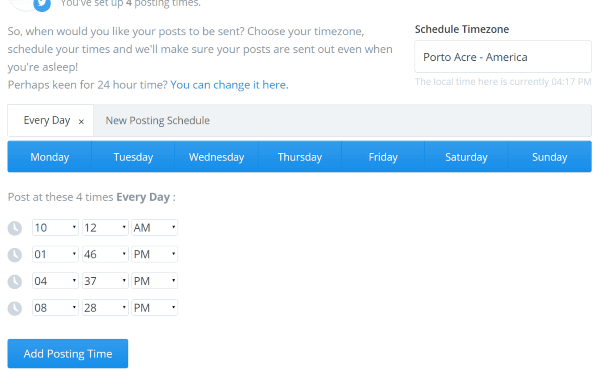
Buffer is a platform that lets you post to multiple social media networks at once. You can schedule your content from anywhere on the web and have it posted at the best times during the day. You can collaborate with your team, too. And it has rich statistics so you can analyze how your posts perform. It connects to Facebook, Twitter, LinkedIn, Google +, and App.net.
Buffer is designed to drive more traffic to your site, increase your fan engagement, and save you time by reducing the time you spend on social media.
The basic Buffer app is free but to get the analytics you will need the Business Plan. There are three business plans. Each of them have unlimited scheduled posts, RSS feed integration, rich analytics, and all standard Buffer features.
For $50 per month you can connect to 25 social accounts and have 5 team members. For $100 per month you can connect to 50 social accounts and have 10 team members. For $250 per month you can connect to 150 social accounts and have 25 team members.
Buffer My Post
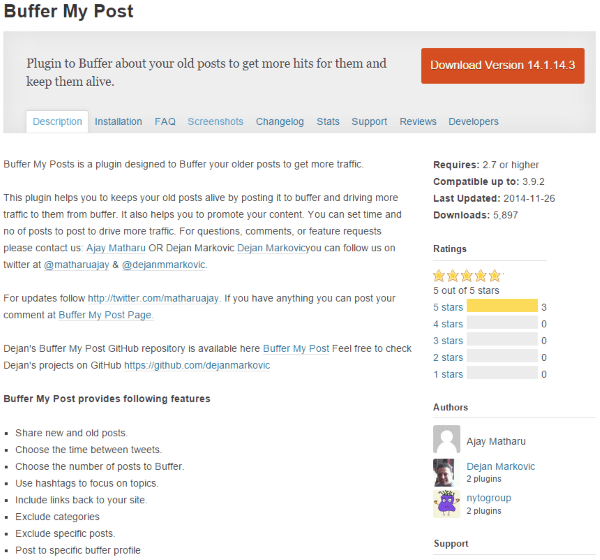
This is a free plugin that allows you to integrate Buffer into WordPress. You can keep your old posts alive by reposting your old posts on a schedule that you set. You set the time and number of posts, share new and old posts, set the time between tweets, use hashtags, include links, exclude categories and specific posts, and post to a specific profile.
TweetDeck
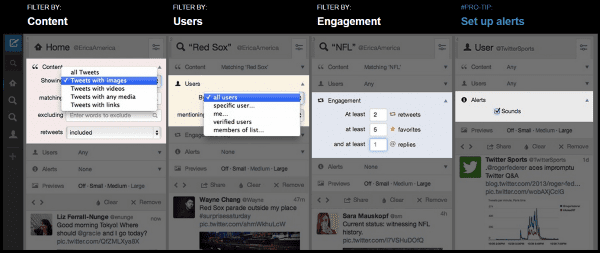
From the makers of Twitter, TweetDeck is available as an app for your desktop or you can use it in your browser. It lets you do real-time tracking of multiple accounts. You can see multiple timelines on the screen at the same time and track each one individually. You can track lists, activity, searches, etc. You can create searches to track specific topics, events, hashtags, and you can filter the results. You can even schedule your tweets for multiple accounts. It only works with Twitter, but it’s free and has lots of good time-saving features.
Hootsuite
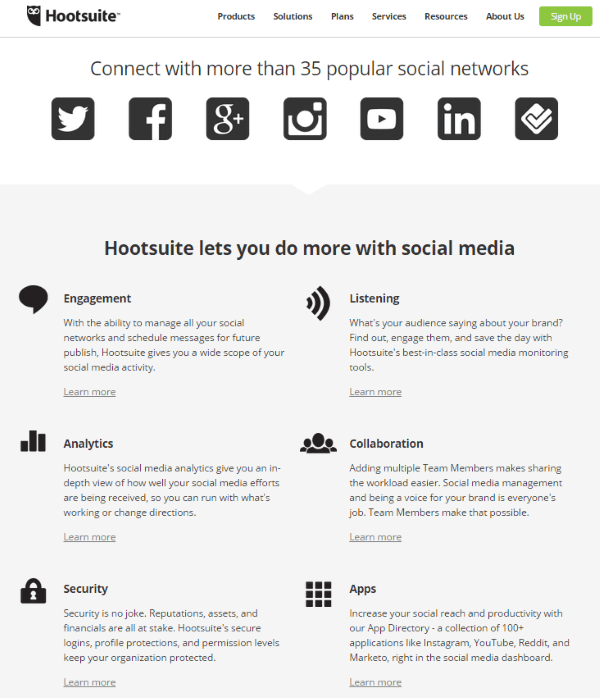
This one allows you to connect to 35 popular social media networks and it has a full range of features. You can manage all your social accounts and schedule posts to each one. You can listen to what your audience has to say about you and your brand. You can increase your social reach by using over 100 apps from their app directory and you can collaborate with team members. There is a whole host of analytics to track your brand growth, visualize your demographics, measure your sentiment, see which of your content resonates with your readers, and get custom reports with drag and drop layouts.
There are three plans: free, pro, and enterprise. Each plan includes different levels of analytics.
The Free Plan connects to 3 social profiles, gives you 3 analytics reports, lets you schedule one post at a time, gives you access to free and paid apps, lets you connect to 2 RSS feeds, and includes Hootsuite University as an option.
The Pro Plan starts at $9.99 per month and connects to 50 social profiles (but it can go up to 100), adds an enhanced report (but it can go up to 10), lets you schedule 350 posts at a time, allows up to 9 team members, has exclusive access to premium apps, unlimited RSS feeds, enhanced security, message archiving (100 included, can go up to 100,000), and a few options such as Hootsuite University, a vanity URL, and technical support.
The Enterprise Plan (prices vary – you have to contact them) has pretty much unlimited everything. It includes Hootsuite University, your very own account rep, geo-targeting, and more.
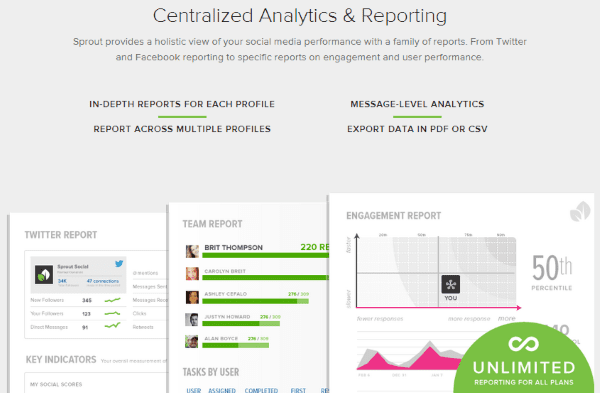
This one lets you manage seven different social media networks from a single dashboard. Its reporting tools include a family of reports that give you in-depth reports for each profile, message level analytics, and exporting via CSV or PDF.
Sprout Social is a premium service that includes Deluxe, Premium, and Team plans.
The Deluxe plan is $59 per user per month and includes an all-in-one social inbox, real-time brand monitoring, publishing, scheduling, and drafting, comprehensive reporting, and lets you manage 10 social profiles.
The Premium plan is $99 per user per month and adds publishing send-time optimization, advanced reporting, helpdesk integration, and lets you mange up to 20 profiles.
The Team plan is $500 per month for 3 users and adds advanced publishing permissions, 24/5 support, custom branding, and lets you manage up to 30 profiles.
Google Analytics Dashboard for WP
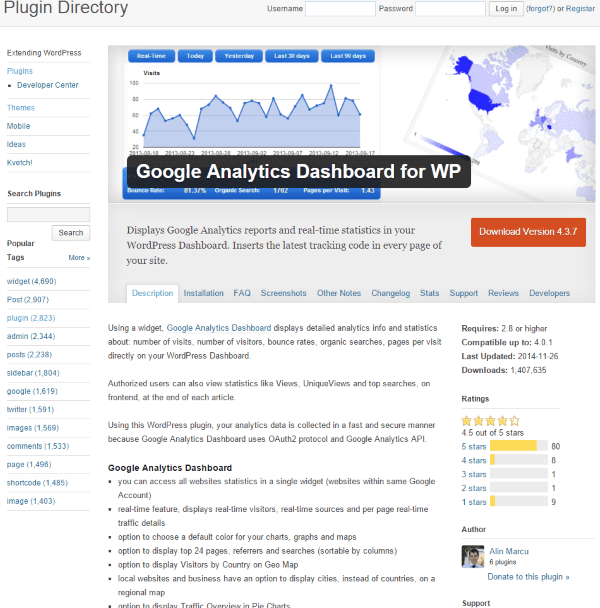
This free plugin displays detailed analytics number of visits, number of visitors, bounce rates, organic searches, and pages per visit. You can see analytics for multiple sites in real time. It also offers pie charts, graphs, maps, and other reports.
Bonus Quick Tips
- Write engaging content. The content you share not only has to support your goals it also has to be relevant to your audience.
- Use images and video to add some sparkle to your posts.
- Post at the best times.
- Improve your headlines and call to action.
Wrapping Up
Analyzing your social media efforts can show you what tasks you complete get you the most return on your investment. This not only tells you about your effectiveness, it also tells you what your readers want from you. By knowing what works and what does not, you will have a better understanding of your audience and their needs. You will be able to give your audience the best possible investment and that investment will give you the best possible return.
How about you? Do you use any of these tools to track your ROI? Do you use different tools or a different method? Do you have any tips for improving ROI? I’d like to hear about it in the comments below!
Article thumbnail image by Dooder / shutterstock.com









Hello Brenda Barron,
Glad to see your article about Social Media ROI. This article is so much helpful for us. And one thing that i can’t be miss here to write that you explain each and every thing about Social Media ROI in a perfect way.All companies that can’t be understand the value of Social Media ROI. Basically, Social Media really is a game changer for businesses small and large. Measuring the impact of social media on sales has become an imperative for businesses.
Thanks
BottomLine Analytics
Great article, good information. Many companies don’t realize the importance of social media ROI, or know how to figure it. iSentia is a company that both monitors and analyzes all forms of media. From social media to tv and radio mentions, and more!
Excellent and helpfull article! If you want to know more about social media ROI, I highly recommend the book by Oliver Blanchard on this subject. Extremely good, extremely easy to read. Combined with this article, you are rocking!
Hey Brand, thanks for sharing this post. We’re looking at Social Media ROI from a different (specific) perspective.
At GetSocial (http://getsocial.io) we help companies track their social sharing activities and understand how those shares are driving business (traffic or conversion-wise).
In this case, we enable companies to know which:
– Users
– Products/Articles/Posts
– Social networks
are more effective to their goals.
Hi Brenda!
Great post. I’m a huge fan of Buffer (and Hootsuite), and use it everyday to schedule posts in my Twitter feed.
On social media ROI, I think it’s extremely hard to measure, and part of me feels it’s not worth measuring b/c someone who follows me, or mentions my business on Twitter may not buy my product right away. They may visit my website, and then forget about me for months. But when they suddenly have the need for it, they’ll remember my brand and then they’ll buy. This makes it very hard to measure. What do you think of that?
BTW, was also wondering if you could try out a tool I developed last year, called BuzzSumo?
It shows you the most shared articles for any topic or competitor, helps you create engaging content, and shows what types of headlines gets the most shares. It’s very useful to use hand-in-hand with Buffer and Hootsuite in terms of finding content to share.
Best,
Henley
How about just writing about what you know and love doing and counting the number of times the phone rings or you get an email saying: “Loved your last blog, we need to meet, we have a big project coming up and we could use your skills” Talk about on the front foot, for me I receive around 5-8 leads a week directly through blogging and sharing, it’s uber-simple and effective to me.
Hi Brenda
I don’t track my social media but I do know how powerful it is.
The Monarch plugin has made it easy to share and I also use the Buffer app for Chrome, which is brilliant.
Many thanks for another complete and in depth post.
Hi Brenda,
I agree that tracking the exact ROI of social media can be difficult. This can be especially frustrating for me at times because my company manages multiple social accounts for 50+ clients. On the other hand, while we can’t always quantify an exact dollar amount we know that it is undoubtedly driving profits for our customers. We know this to be true because we track and monitor using hootsuite and google analytics among other tools and the data corresponds with increased web traffic and profitability.
Thanks for such an insightful post today 🙂
Adam
Well, ROI of social media depends on the many factors, what you achieved, how many bucks you did invested! what was your goals and so on!
By the way, thanks a lot Brenda for this informations.